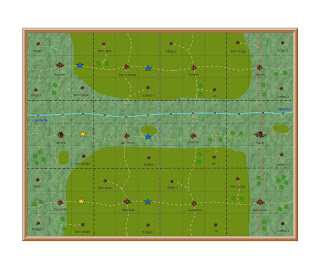To play test the new rules I have set up a table with the three types of objective which I want to improve. On the left a hill. In the centre open combat. On the right a farm. The white card is artillery long range. I will test play new rules for each of these combats using just one corps v one corps.
As always the outcome will be decided by a dice throw. However I have decided to simplify how this will work. First I have replaced the use of 2D6 with 1D6. I have also greatly reduced the list of plus and minus combat factors.
During the rule testing period I will always use a dice throw of 3. This will allow me to test each new rule without the complication of high or low dice rolls. In general terms a roll of 1 or 6 will produce extreme results. 2 and 5 will favour one side or the other. 3 or 4 will produce the same result for both sides.
I have given up on trying to make wargames “realistic”. It has long been obvious to me that moving model soldiers around on a table will never reproduce the conditions of a real battle. The best we can hope for is to get a feel of what it was like to command a Napoleonic battle. This is done partly by well painted models and nice looking scenery. It is enhanced by adding a campaign background to the wargame. But what it should feel like is always going to be a very personal thing.
Combat factors are the means of getting “the feel right”. However too often players try to cover every possible factor. This results in very long lists of plus and minus factors, most of which then just add a lot of time to reaching a solution to a combat or morale test.
I have reduced them to quality of troops, current morale, supports, casualties and command bonus. The total is then added to the 1D6. This removes the need to consult the lists. It also prompts the player to position generals and supports carefully. If the result proves not to achieve what I want, I don’t need to add more factors. I just need to adjust the dice result. This is much easier using just 1D6 rather than two or more.
I have written the first draft of the new rules. The next step is to play test them. By next week I should have a much better idea of whether I can achieve what I want with what I plan to do.






